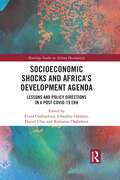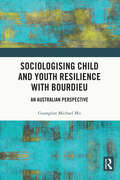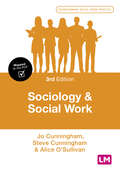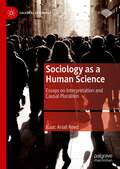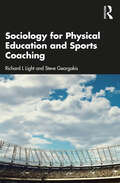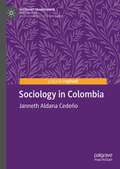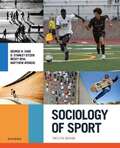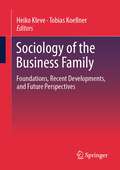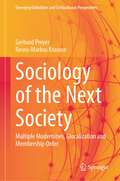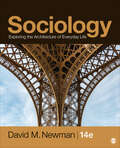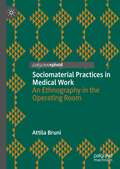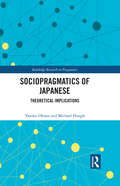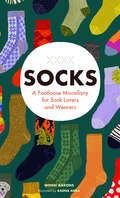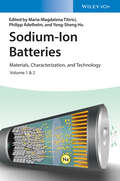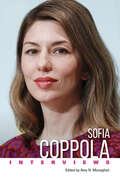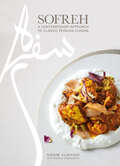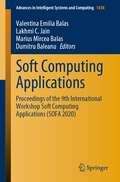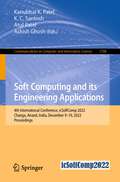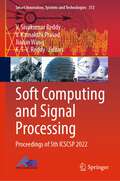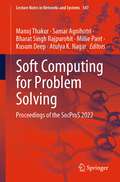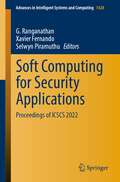- Table View
- List View
Socioeconomic Shocks and Africa’s Development Agenda: Lessons and Policy Directions in a Post-COVID-19 Era (Routledge Studies in African Development)
by Gbadebo Odularu Evans Osabuohien Daniel Ufua Romanus OsabohienThis book investigates how African countries respond to socioeconomic shocks, drawing out lessons to help to inform future policy and development efforts. The challenges posed by the COVID-19 pandemic affected all sectors of the economy, exposing substantial structural weaknesses and complexities in supply chains and logistics across the African continent. This book examines the disruptive impact of the pandemic across Africa. However, it also goes beyond the current crisis to investigate how socioeconomic pressures in general impact commodity prices, national budgeting processes, food, business, energy sectors, education, health, and sanitation. Overall, the book presents evidence-based solutions and policy recommendations to enable readers to improve resilience and responses to future crises. The insights provided by this book will be of interest to policymakers and development agencies, as well as to researchers of global development, politics, economics, business, and African studies.
Sociologising Child and Youth Resilience with Bourdieu: An Australian Perspective
by Guanglun Michael MuIn this book, Mu crafts a sociology of resilience through his multi-year research with Australian students. The content is not merely concerned with individual achievements in precarious conditions but also ponders over transformative, reflexive, and power-rejective everyday practices that make social change possible, probable, and even inevitable. Since Emmy Werner and her colleagues discovered the "self-righting" and "invincible" children on the Hawaiian island of Kauai who fared well despite exposure to significant household risks, positive psychology has markedly advanced the knowledge about child and youth resilience to adversities. Yet, many children and adolescents continue to slide through system cracks. This fact does not invalidate psychology of resilience; rather, it urges new frameworks to break the reproductive circle of inequality. Reframing the traditional psychological notion of resilience through recourse to Bourdieu’s relational and reflexive sociology, the book moves beyond individual adaptation to adverse conditions and takes a deep dive into sociological resilience to structural problems. It offers school professionals and educational researchers an epistemological tool to reapproach resilience and reappropriate Bourdieu for social change. Offering scholarship that will interest researchers in the areas of child and youth resilience, sociology of resilience, and sociology of education, the volume is written to engage with the intellectual work of both established scholars and emerging researchers within Australia and beyond. The empirical analyses also provide useful insights for educational professionals in schools and resilience researchers in universities.
Sociology and Social Work (Transforming Social Work Practice Series)
by Jo Cunningham Steve Cunningham Alice O′SullivanSociological perspectives can be used to analyse societal and structural influences on human behaviour at individual, group and community levels. The authors link sociological concepts, debates and theories relating to key areas such as poverty, social exclusion, education, social class and social justice to develop your students′ understanding of how sociological perspectives will impact upon their social work placements and practice. This book begins by taking you step-by-step through the ins and outs of why sociology is important to social work. It explains the relevance of sociology to everyday social work practice, introducing you to the core sociological perspectives that you′ll need to get to grips with during your course, including functionalism, Marxism, symbolic interactionism and postmodernism. The book then moves on to explore various social issues in detail (i.e. poverty, social class, social exclusion, education, moral panics), with extended case studies, activities and links to skills in practice illustrating the many opportunities and challenges that each aspect brings to everyday practice. There are also important chapters on family, community and the role of sociology in social work training.
Sociology and Social Work (Transforming Social Work Practice Series)
by Jo Cunningham Steve Cunningham Alice O′SullivanSociological perspectives can be used to analyse societal and structural influences on human behaviour at individual, group and community levels. The authors link sociological concepts, debates and theories relating to key areas such as poverty, social exclusion, education, social class and social justice to develop your students′ understanding of how sociological perspectives will impact upon their social work placements and practice. This book begins by taking you step-by-step through the ins and outs of why sociology is important to social work. It explains the relevance of sociology to everyday social work practice, introducing you to the core sociological perspectives that you′ll need to get to grips with during your course, including functionalism, Marxism, symbolic interactionism and postmodernism. The book then moves on to explore various social issues in detail (i.e. poverty, social class, social exclusion, education, moral panics), with extended case studies, activities and links to skills in practice illustrating the many opportunities and challenges that each aspect brings to everyday practice. There are also important chapters on family, community and the role of sociology in social work training.
Sociology as a Human Science: Essays on Interpretation and Causal Pluralism (Cultural Sociology)
by Isaac Ariail ReedSociology as a Human Science is a set of foundational, wide-ranging and updated essays from Isaac Ariail Reed. Gathered together for the first time with a new introduction, they articulate a distinct perspective on concept and method in social science. Reed writes about realism and positivism, postmodernism and empiricism, mechanisms and causality, and power and history, developing thereby an understanding of the key debates out of which 21st-century sociology has developed. Carefully considering all manner of arguments in metatheory and epistemology and moving towards a program of interpretive explanation focused on culture and power, Reed places sociology at the center of debates about knowledge production across the humanities and social sciences. His reconstructive approach, positioned “after the posts” (poststructuralism, postmodernism, and postcolonialism) provides a way for interpretive sociology to provide analytically sound, theoretically extensive, and empirically rich understandings of social life.
Sociology for Physical Education and Sports Coaching
by Richard L Light Steve GeorgakisThis book introduces the fundamentals of sport sociology and social issues in sport for students of physical education (PE) and coaching. It provides an accessible, jargon-free foundation for understanding the relationships between sport, education, and wider society that puts into context the reader's applied studies in PE and coaching. Drawing on cutting-edge research, this book examines core topics in the study of sport and society, including the origins of sport, sport education, sport as business, commodification, globalisation, sport and health, sport and the media, gender, migration, and Indigenous people in sport. Throughout this book, in-depth ‘commentary’ pieces look closely at particular pieces of research that illustrate the sociological themes being examined, from the impact of sport media on school children to the effects of hegemonic masculinity in rugby. This book is invaluable reading for any course on sport and society, physical education, sports coaching, or sport development.
Sociology in Colombia (Sociology Transformed)
by Janneth Aldana CedeñoThis Palgrave Pivot presents a historical reflection about the development of sociology in Colombia from the late nineteenth century into the mid-twentieth century, a period in which the process of professionalization in the discipline occurred due to the creation of university training programs, as well as the extension of research centers and groups nationwide. The book exposes the different interrelations at the local, regional and international ambits that, only in part, offer a similar panorama to what happened in other Latin American processes in relation to the academic institutionalization of sociology. The role of international networks and government initiatives, national and foreign, was central to this development and, in general, to the take-off of sociology in the country, as happened in others nations such as Argentina, Brazil and Mexico. This book argues that, in Colombia, having these networks and initiatives during the Cold War generated various tensions, which appeared early, between these forms of financing as a political effort to contain left movements in the region (especially after the Cuban Revolution) and the attempt to achieve an autonomous science. However, the Colombian case presents some peculiarities in the configuration of sociology at the national level. These are associated, to a large extent, with the phenomena that have been decisive in the history of the country: a nation without dictatorships between 1960 and 1970, unlike other South American countries, but with a restricted democracy that even today offers difficulties in order to accept alternative forces. This book also considers the effects of the longest armed conflict known in the continent and its own historical transformations in the face of the role played by various actors such as guerrillas, drug trafficking and paramilitary groups. The book thus discusses, under a specific case study, the role of science as well as the possibilities of social transformation through human action. This book constitutes not only a journey on the academic institutionalization and the professional practice of sociology in Colombia; it is also an opportunity to think about what is coming in this field in a possible post-conflict scenario.
Sociology in Modules
by Richard T. SchaeferSociology in Modules takes a traditional approach to Introduction to Sociology―while presenting material in a flexible way that allows instructors to select and organize reading assignments in the best order for their course.
Sociology of Sport
by D. Stanley Eitzen George H. Sage Matthew Atencio Becky BealThis engaging, comprehensive textbook for sociology of sport courses takes a critical approach, focusing in particular on issues of power and inequality. By addressing questions such as "Are sports free of racism and sexism?" and "Who pays for, and who benefits from, sports?", students understand sport from a sociological perspective rather than as simply a spectator or participant.
Sociology of the Business Family: Foundations, Recent Developments, and Future Perspectives
by Tobias Koellner Heiko KleveThe entrepreneurial family has hardly been a topic of family sociology so far. Precisely because more than two-thirds of all companies are family-run, it is surprising that sociology has not yet discovered the entrepreneurial family as a field of research. With this book, it is made the content of systematic family sociological reflections.A central point of departure for theorizing and research on entrepreneurial families is that this form of family has to deal with special social challenges because it structurally combines, mixes, and couples two social spheres that are generally pulled apart in the course of the modernization of society, namely families as part of the private life world and companies as the formal organization of the economic system.This book is a translation of an original German edition. The translation was done with the help of artificial intelligence (machine translation by the service DeepL.com). A subsequent human revision was also carried out by the authors and a native speaker.
Sociology of the Next Society: Multiple Modernities, Glocalization and Membership Order (Emerging Globalities and Civilizational Perspectives)
by Gerhard Preyer Reuss-Markus KrausseThis innovative volume provides insight into the vast changes in societies now and in the near future, and highlights the need for a new sociological approach to analyse these changes. It particularly reviews and critiques existing theories of globalization and analyses how global changes affect all subsystems of social membership systems: the scientific, academic, legal and political systems. The authors propose a new theoretical paradigm in sociology to analyse this “next society”. The book studies emergent communication structures between these systems and looks at the concept of membership as a new research area in the study of the next society. In this context, it particularly assesses the problems of further modernization of Chinese society, and the directions of this modernization.This book is of interest to researchers and students of social theory, globalization studies, theory of evolution, and those studying modern Chinese society.
Sociology: Exploring the Architecture of Everyday Life
by David M. NewmanIn the Fourteenth Edition of Sociology: Exploring the Architecture of Everyday Life, David Newman shows students how to see the "unfamiliar in the familiar"—to step back and see organization and predictability in their take-for-granted personal experiences. With his approachable writing style and lively anecdotes, the author’s goal from the first edition has been the same: to write a textbook that "reads like a real book." Many adopters of this book are fans of Peter Berger′s classic works, which helped introduce the idea of "social constructionism" to sociology. Newman uses the metaphors of "architecture" and "construction" to help students understand that society is not something that exists "out there," independently of themselves; it is a human creation that is planned, maintained, or altered by individuals. Using vivid prose, current examples, and fresh data, this text presents a unique and thought-provoking overview of how society is constructed and experienced. Instead of surveying every subfield in sociology, the more streamlined coverage (14 chapters) focuses on the individual and society, the construction of self and society, and social inequality in the context of social structures. This title is accompanied by a complete teaching and learning package. Contact your SAGE representative to request a demo. Digital Option / Courseware SAGE Vantage is an intuitive digital platform that delivers this text’s content and course materials in a learning experience that offers auto-graded assignments and interactive multimedia tools, all carefully designed to ignite student engagement and drive critical thinking. Built with you and your students in mind, it offers simple course set-up and enables students to better prepare for class. Learn more. Assignable Video with Assessment Assignable video (available with SAGE Vantage) is tied to learning objectives and curated exclusively for this text to bring concepts to life. Watch a sample video now. LMS Cartridge: Import this title’s instructor resources into your school’s learning management system (LMS) and save time. Don’t use an LMS? You can still access all of the same online resources for this title via the password-protected Instructor Resource Site. Learn more.
Sociology: Exploring the Architecture of Everyday Life
by David M. NewmanIn the Fourteenth Edition of Sociology: Exploring the Architecture of Everyday Life, David Newman shows students how to see the "unfamiliar in the familiar"—to step back and see organization and predictability in their take-for-granted personal experiences. With his approachable writing style and lively anecdotes, the author’s goal from the first edition has been the same: to write a textbook that "reads like a real book." Many adopters of this book are fans of Peter Berger′s classic works, which helped introduce the idea of "social constructionism" to sociology. Newman uses the metaphors of "architecture" and "construction" to help students understand that society is not something that exists "out there," independently of themselves; it is a human creation that is planned, maintained, or altered by individuals. Using vivid prose, current examples, and fresh data, this text presents a unique and thought-provoking overview of how society is constructed and experienced. Instead of surveying every subfield in sociology, the more streamlined coverage (14 chapters) focuses on the individual and society, the construction of self and society, and social inequality in the context of social structures. This title is accompanied by a complete teaching and learning package. Contact your SAGE representative to request a demo. Digital Option / Courseware SAGE Vantage is an intuitive digital platform that delivers this text’s content and course materials in a learning experience that offers auto-graded assignments and interactive multimedia tools, all carefully designed to ignite student engagement and drive critical thinking. Built with you and your students in mind, it offers simple course set-up and enables students to better prepare for class. Learn more. Assignable Video with Assessment Assignable video (available with SAGE Vantage) is tied to learning objectives and curated exclusively for this text to bring concepts to life. Watch a sample video now. LMS Cartridge: Import this title’s instructor resources into your school’s learning management system (LMS) and save time. Don’t use an LMS? You can still access all of the same online resources for this title via the password-protected Instructor Resource Site. Learn more.
Sociomaterial Practices in Medical Work: An Ethnography in the Operating Room
by Attila BruniThis book presents a sociomaterial perspective on work and organizational practices within the operating room. Looking at medical work from a sociological perspective and drawing on ethnographic observations conducted in a hospital's operating block, this book analyses the entanglements of humans and technologies in the execution of everyday activities. It highlights how the sociomateriality of work and organizational practices manifests in the encounters between operators and material artifacts and in the way objects and technologies participate in processes and practices of organizational communication. Objects and technologies are also shaped by these very practices, giving rise to a recursive relationship wherein technology, communication, and organizing are intertwined.A sociomaterial understanding of organizational and working practices explains the role of objects and technologies in the generation and enactment of professional knowledge, while questioning how power materializes through the interaction of humans and technical objects. This book will be of great interest to scholars, students, and practitioners interested in how sociomaterial perspectives can inform organization studies and reshape our understanding of the intricate relationships between humans and technologies in healthcare settings.
Sociopragmatics of Japanese: Theoretical Implications (Routledge Research in Pragmatics)
by Michael Haugh Yasuko ObanaObana and Haugh question the extent to which commonly accepted theories in pragmatics can readily explain sociopragmatic phenomena in Japanese. Studies of Japanese in pragmatics have often challenged the cross-linguistic relevance of dominant theories. However, they have also inadvertently perpetuated stereotypes about the Japanese. It is often been assumed, for instance, that Japanese people are less strategic, more polite and more reliant on tacit forms of communication than speakers of other languages. But the Japanese are not as polite as one might think. The aim of this book is thus to question those folk assumptions around politeness, impoliteness, irony and indirectness while at the same time emphasizing that close examination of sociopragmatic phenomena in Japanese yields important empirical insights that combat common theoretical assumptions in pragmatics. The content is structured in three parts, in which the authors highlight a key building block of a theory of sociopragmatics. Part I focuses on indexing through the lens of chapters on honorifics, routine formula and politeness strategies. Part II focuses on evaluating through the lens of chapters on giving/receiving expressions and honorific irony. Finally, Part III focuses on relating through the lens of chapters on joint utterances and off record requests. Throughout the chapters the authors draw attention to ways in which these three dimensions are invariably intertwined in various ways. This book is not simply a collection of studies that promotes our understanding of the sociopragmatics of a particular language, but goes deeper and challenges what many have taken for granted in pragmatics. It proposes a framework for exploring sociopragmatic phenomena, building on the key sociopragmatic axes of indexing, evaluating and relating, and offers fresh new perspectives on time-honoured phenomena in pragmatics. It will interest scholars and postgraduate students in pragmatics, particularly those specializing in: politeness, impoliteness, indirectness and irony. The book explains what Japanese terms mean, and all the Japanese examples are morphologically-glossed. Therefore, teachers (and advanced learners) of Japanese at all levels will benefit from the book as it will enrich their knowledge of the Japanese language.
Socks: A Footloose Miscellany for Sock Lovers and Wearers
by Wendi AaronsDo you wear socks? If so, you'll love this book!Amusing and highly giftable, Socks is an illustrated miscellany all about the most common accessory. Through humorous text and quirky art, discover what different types of socks say about the people who wear them:Striped socks? A bit whimsical. A bit arty. Loves museum gift shops.Dress socks? Proud owner of three pairs of loafers, three Labradors, and three 401(k)s.Socks with bad elastic that really need to be thrown away? This person is not a quitter—unlike these crappy socks.Also included are important things such as musings from the Sock Monkey, a timeline of famous socks throughout history, and postcards from your lost socks. (Where did they go? Will they ever come back?) Packaged in a tall, narrow trim, this book is a perfect add-on gift alongside a nice pair of—you guessed it—socks. And who doesn't love socks?GO-TO GIFT: Socks are the best, easiest gift for everyone, including anyone that's hard to buy for. Package a pair with this book to create the perfect gift for countless occasions. Give Socks to your father-figure on Father's Day; as a novelty stocking stuffer; to your new love interest on Valentine's Day; at the office white elephant gift exchange; as an anytime present for a sock-loving BFF . . . you get the idea.FOR EVERYONE: Socks (and this book) are gender neutral and age agnostic. After all, everyone wears socks! Men who don';t otherwise play with their fashion choices are often more experimental with socks, and people of all ages appreciate warm feet. This quippy book will appeal to a broad range of sock wearers and collectors. AFFORDABLE AND FUN: Socks is a happiness-inducing add-on gift or impulse purchase for yourself or a fashion-forward friend.Perfect for:People who wear (or like to receive) socksSock collectors and aficionados of all agesDads and dudes, moms and mavensGift givers seeking something unique for Father's Day, Mother's Day, a birthday, graduation, the holidays, or just for fun
Sodium-Ion Batteries: Materials, Characterization, and Technology, 2 Volumes
by Maria-Magdalena Titirici Philipp Adelhelm Yong-Sheng HuPresents uparalleled coverage of Na-ion battery technology, including the most recent research and emerging applications Na-ion battery technologies have emerged as cost-effective, environmentally friendly alternatives to Li-ion batteries, particularly for large-scale storage applications where battery size is less of a concern than in portable electronics or electric vehicles. Scientists and engineers involved in developing commercially viable Na-ion batteries need to understand the state-of-the-art in constituent materials, electrodes, and electrolytes to meet both performance metrics and economic requirements. Sodium-Ion Batteries: Materials, Characterization, and Technology provides in-depth coverage of the material constituents, characterization, applications, upscaling, and commercialization of Na-ion batteries. Contributions by international experts discuss the development and performance of cathode and anode materials and their characterization - using methods such as NMR spectroscopy, magnetic resonance imaging (MRI), and computational studies - as well as ceramics, ionic liquids, and other solid and liquid electrolytes. Discusses the development of battery technology based on the abundant alkali ion sodium Features a thorough introduction to Na-ion batteries and their comparison with Li-ion batteries Reviews recent research on the structure-electrochemical performance relationship and the development of new solid electrolytes Includes a timely overview of commercial perspectives, cost analysis, and safety issues of Na-ion batteries Covers emerging technologies including Na-ion capacitors, aqueous sodium batteries, and Na-S batteriesThe handbook Sodium-Ion Batteries: Materials, Characterization, and Technology is an indispensable reference for researchers and development engineers, materials scientists, electrochemists, and engineering scientists in both academia and industry.
Sofia Coppola: Interviews (Conversations with Filmmakers Series)
by Amy N. MonaghanSofia Coppola (b. 1971) was baptized on film. After appearing in The Godfather as an infant, it took twenty-five years for Coppola to take her place behind the camera, helming her own adaptation of Jeffrey Eugenides’s celebrated novel The Virgin Suicides. Following her debut, Coppola was the third woman ever to be nominated for Best Director and became an Academy Award winner for Best Original Screenplay for her sophomore feature, Lost in Translation. She has also been awarded the Golden Lion at the Venice Film Festival and Best Director at Cannes. In addition to her filmmaking, Coppola is recognized as an influential tastemaker. She sequenced the so-called Tokyo dream pop of the Lost in Translation soundtrack like an album, a success in its own right. Her third film, Marie Antoinette, further showcased Coppola’s ear for the unexpected needle drop, soundtracking the controversial queen’s life with a series of New Romantic bangers popular during the director’s adolescence. The conversations compiled within Sofia Coppola: Interviews mark the filmmaker’s progression from dismissed dilettante to acclaimed auteur of among the most visually arresting, melancholy, and wryly funny films of the twenty-first century. Coppola discusses her approach to collaboration, Bill Murray as muse, and how Purple Rain blew her twelve-year-old mind. There are interviews from major publications, but Coppola speaks with musician Kim Gordon for indie magazine Bust and Tavi Gevinson, then-adolescent founder of online teen magazine Rookie, as well. The volume also features a new and previously unpublished interview conducted with volume editor Amy N. Monaghan in which Coppola discusses her plans for the now-cancelled adaptation of The Custom of the Country. To read these interviews is to witness Sofia Coppola coming into her own as a world-renowned artist.
Sofreh: A Contemporary Approach to Classic Persian Cuisine: A Cookbook
by Theresa Gambacorta Nasim AlikhaniThe much-anticipated cookbook—an exquisite collection of Persian recipes—from the James Beard–nominated chef of Sofreh, one of Brooklyn&’s most acclaimed restaurants."I got lost in the flavors of Nasim&’s mint oil, saffron rice pudding, and meltingly tender chicken stew laced with sweet-tart flavors from Pink Lady Apples and sour cherries. Her naan e-barbari is the best!" —Suzy Karadsheh, New York Times best-selling author of The Mediterranean Dish CookbookGrowing up in Isfahan, a province in central Iran, Nasim Alikhani was a passionate cook from childhood, spending the first years of her life in the kitchen alongside her mother. And so, when she departed after the revolution it was by re-creating the dishes of her youth that she was able to feel connected to her home. After decades of cooking for friends and family, at the age of fifty-nine she opened Sofreh restaurant in Brooklyn, to share the food and warm culture of her native Iran with a wider circle.Now, in her first cookbook, Alikhani offers her readers what she has lovingly been providing for those who know her and who eat in her restaurant: the true tastes of Iran. Here is the timeless, soul-satisfying food of Persia, with its trademark bold herb and spice flavors, succulent, savory stews and stuffed meats, vast bounty of brightly pickled vegetables and fresh fruits, and much, much more.Containing more than 120 recipes, Sofreh brings together traditional Iranian dishes and modern Sofreh favorites.Sour Cherry RiceRoasted Cauliflower with Shallot Yogurt and PistachiosSour Chicken StewRosewater and Cardamom Custardand, of course, everything you need to create a true Iranian breakfast spread at homeA joyous celebration of one of the world&’s great cuisines, this essential guide will delight home cooks everywhere.
Soft Computing Applications in Modern Power and Energy Systems: Select Proceedings of EPREC 2022 (Lecture Notes in Electrical Engineering #975)
by Narayana Prasad Padhy Krishna Murari Sukumar KamalasadanThis book provides rigorous discussions, case studies, and recent developments in soft computing and its application in power systems enabled with power electronics-based equipment, biomedical engineering, and image processing. The readers would be benefitted from enhancing their knowledge and skills in the domain areas. This book also helps the readers in developing new and innovative ideas.
Soft Computing Applications: Proceedings of the 9th International Workshop Soft Computing Applications (SOFA 2020) (Advances in Intelligent Systems and Computing #1438)
by Lakhmi C. Jain Dumitru Baleanu Valentina Emilia Balas Marius Mircea BalasSoft computing techniques open significant opportunities in several areas, such as industry, medicine, energy, security, transportation, and education. This book provides theory and applications development using soft computing techniques by organizing intelligent systems for many applications to the benefit of humanity. The book comes from a multidisciplinary subject whose audience can come from different academic departments, e.g., department of computer science and engineering, department of medical imaging, department of biomedical informatics, department of education sciences, and so on where artificial intelligence and soft computing are of routine courses. The book covers a range of audience from academicians, practitioners, researchers, and students to stakeholders. It can support graduate students and interns to develop a deep understanding of the latest paradigms in the soft computing techniques.
Soft Computing and Its Engineering Applications: 4th International Conference, icSoftComp 2022, Changa, Anand, India, December 9–10, 2022, Proceedings (Communications in Computer and Information Science #1788)
by K. C. Santosh Ashish Ghosh Kanubhai K. Patel Atul PatelThis book constitutes the refereed proceedings of the 4th International Conference on Soft Computing and its Engineering Applications, icSoftComp 2022, held in Changa, Anand, India during December 9–10, 2022. The 33 full papers and 3 short papers included in this book were carefully reviewed and selected from 342 submissions. They were organized in topical sections as follows: Theory and Methods; Systems and Applications; and Hybrid Techniques.
Soft Computing and Signal Processing: Proceedings of 5th ICSCSP 2022 (Smart Innovation, Systems and Technologies #313)
by V. Kamakshi Prasad Jiacun Wang V. Sivakumar Reddy K. T. V. ReddyThis book presents selected research papers on current developments in the fields of soft computing and signal processing from the Fifth International Conference on Soft Computing and Signal Processing (ICSCSP 2022). The book covers topics such as soft sets, rough sets, fuzzy logic, neural networks, genetic algorithms and machine learning and discusses various aspects of these topics, e.g., technological considerations, product implementation and application issues.
Soft Computing for Problem Solving: Proceedings of the SocProS 2022 (Lecture Notes in Networks and Systems #547)
by Millie Pant Kusum Deep Atulya K. Nagar Manoj Thakur Samar Agnihotri Bharat Singh RajpurohitThis book provides an insight into the 11th International Conference on Soft Computing for Problem Solving (SocProS 2022). This international conference is a joint technical collaboration of the Soft Computing Research Society and the Indian Institute of Technology Mandi. This book presents the latest achievements and innovations in the interdisciplinary areas of Soft Computing, Machine Learning, and Data Science. It brings together the researchers, engineers, and practitioners to discuss thought-provoking developments and challenges, in order to select potential future directions. It covers original research papers in the areas including but not limited to algorithms (artificial neural network, deep learning, statistical methods, genetic algorithm, and particle swarm optimization) and applications (data mining and clustering, computer vision, medical and healthcare, finance, data envelopment analysis, business, and forecasting applications). This book is beneficial for young as well as experienced researchers dealing across complex and intricate real-world problems for which finding a solution by traditional methods is a difficult task.
Soft Computing for Security Applications: Proceedings of ICSCS 2022 (Advances in Intelligent Systems and Computing #1428)
by Selwyn Piramuthu Xavier Fernando G. RanganathanThis book features selected papers from the International Conference on Soft Computing for Security Applications (ICSCS 2022), held at Dhirajlal Gandhi College of Technology, Tamil Nadu, India, during April 21–22, 2022. It covers recent advances in the field of soft computing techniques such as fuzzy logic, neural network, support vector machines, evolutionary computation, machine learning and probabilistic reasoning to solve various real-time challenges. This book presents innovative work by leading academics, researchers, and experts from industry.
